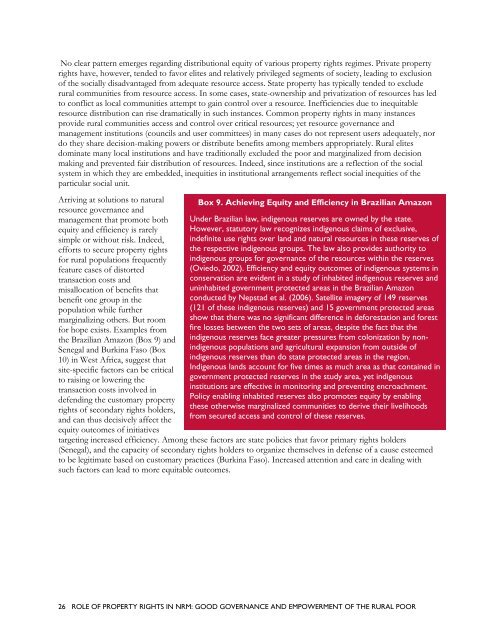the role of property rights in natural resource management, good ...
the role of property rights in natural resource management, good ...
the role of property rights in natural resource management, good ...
Create successful ePaper yourself
Turn your PDF publications into a flip-book with our unique Google optimized e-Paper software.
No clear pattern emerges regard<strong>in</strong>g distributional equity <strong>of</strong> various <strong>property</strong> <strong>rights</strong> regimes. Private <strong>property</strong><strong>rights</strong> have, however, tended to favor elites and relatively privileged segments <strong>of</strong> society, lead<strong>in</strong>g to exclusion<strong>of</strong> <strong>the</strong> socially disadvantaged from adequate <strong>resource</strong> access. State <strong>property</strong> has typically tended to excluderural communities from <strong>resource</strong> access. In some cases, state-ownership and privatization <strong>of</strong> <strong>resource</strong>s has ledto conflict as local communities attempt to ga<strong>in</strong> control over a <strong>resource</strong>. Inefficiencies due to <strong>in</strong>equitable<strong>resource</strong> distribution can rise dramatically <strong>in</strong> such <strong>in</strong>stances. Common <strong>property</strong> <strong>rights</strong> <strong>in</strong> many <strong>in</strong>stancesprovide rural communities access and control over critical <strong>resource</strong>s; yet <strong>resource</strong> governance and<strong>management</strong> <strong>in</strong>stitutions (councils and user committees) <strong>in</strong> many cases do not represent users adequately, nordo <strong>the</strong>y share decision-mak<strong>in</strong>g powers or distribute benefits among members appropriately. Rural elitesdom<strong>in</strong>ate many local <strong>in</strong>stitutions and have traditionally excluded <strong>the</strong> poor and marg<strong>in</strong>alized from decisionmak<strong>in</strong>g and prevented fair distribution <strong>of</strong> <strong>resource</strong>s. Indeed, s<strong>in</strong>ce <strong>in</strong>stitutions are a reflection <strong>of</strong> <strong>the</strong> socialsystem <strong>in</strong> which <strong>the</strong>y are embedded, <strong>in</strong>equities <strong>in</strong> <strong>in</strong>stitutional arrangements reflect social <strong>in</strong>equities <strong>of</strong> <strong>the</strong>particular social unit.Arriv<strong>in</strong>g at solutions to <strong>natural</strong><strong>resource</strong> governance and<strong>management</strong> that promote bo<strong>the</strong>quity and efficiency is rarelysimple or without risk. Indeed,efforts to secure <strong>property</strong> <strong>rights</strong>for rural populations frequentlyfeature cases <strong>of</strong> distortedtransaction costs andmisallocation <strong>of</strong> benefits thatbenefit one group <strong>in</strong> <strong>the</strong>population while fur<strong>the</strong>rmarg<strong>in</strong>aliz<strong>in</strong>g o<strong>the</strong>rs. But roomfor hope exists. Examples from<strong>the</strong> Brazilian Amazon (Box 9) andSenegal and Burk<strong>in</strong>a Faso (Box10) <strong>in</strong> West Africa, suggest thatsite-specific factors can be criticalto rais<strong>in</strong>g or lower<strong>in</strong>g <strong>the</strong>transaction costs <strong>in</strong>volved <strong>in</strong>defend<strong>in</strong>g <strong>the</strong> customary <strong>property</strong><strong>rights</strong> <strong>of</strong> secondary <strong>rights</strong> holders,and can thus decisively affect <strong>the</strong>equity outcomes <strong>of</strong> <strong>in</strong>itiativesBox 9. Achiev<strong>in</strong>g Equity and Efficiency <strong>in</strong> Brazilian AmazonUnder Brazilian law, <strong>in</strong>digenous reserves are owned by <strong>the</strong> state.However, statutory law recognizes <strong>in</strong>digenous claims <strong>of</strong> exclusive,<strong>in</strong>def<strong>in</strong>ite use <strong>rights</strong> over land and <strong>natural</strong> <strong>resource</strong>s <strong>in</strong> <strong>the</strong>se reserves <strong>of</strong><strong>the</strong> respective <strong>in</strong>digenous groups. The law also provides authority to<strong>in</strong>digenous groups for governance <strong>of</strong> <strong>the</strong> <strong>resource</strong>s with<strong>in</strong> <strong>the</strong> reserves(Oviedo, 2002). Efficiency and equity outcomes <strong>of</strong> <strong>in</strong>digenous systems <strong>in</strong>conservation are evident <strong>in</strong> a study <strong>of</strong> <strong>in</strong>habited <strong>in</strong>digenous reserves andun<strong>in</strong>habited government protected areas <strong>in</strong> <strong>the</strong> Brazilian Amazonconducted by Nepstad et al. (2006). Satellite imagery <strong>of</strong> 149 reserves(121 <strong>of</strong> <strong>the</strong>se <strong>in</strong>digenous reserves) and 15 government protected areasshow that <strong>the</strong>re was no significant difference <strong>in</strong> deforestation and forestfire losses between <strong>the</strong> two sets <strong>of</strong> areas, despite <strong>the</strong> fact that <strong>the</strong><strong>in</strong>digenous reserves face greater pressures from colonization by non<strong>in</strong>digenouspopulations and agricultural expansion from outside <strong>of</strong><strong>in</strong>digenous reserves than do state protected areas <strong>in</strong> <strong>the</strong> region.Indigenous lands account for five times as much area as that conta<strong>in</strong>ed <strong>in</strong>government protected reserves <strong>in</strong> <strong>the</strong> study area, yet <strong>in</strong>digenous<strong>in</strong>stitutions are effective <strong>in</strong> monitor<strong>in</strong>g and prevent<strong>in</strong>g encroachment.Policy enabl<strong>in</strong>g <strong>in</strong>habited reserves also promotes equity by enabl<strong>in</strong>g<strong>the</strong>se o<strong>the</strong>rwise marg<strong>in</strong>alized communities to derive <strong>the</strong>ir livelihoodsfrom secured access and control <strong>of</strong> <strong>the</strong>se reserves.target<strong>in</strong>g <strong>in</strong>creased efficiency. Among <strong>the</strong>se factors are state policies that favor primary <strong>rights</strong> holders(Senegal), and <strong>the</strong> capacity <strong>of</strong> secondary <strong>rights</strong> holders to organize <strong>the</strong>mselves <strong>in</strong> defense <strong>of</strong> a cause esteemedto be legitimate based on customary practices (Burk<strong>in</strong>a Faso). Increased attention and care <strong>in</strong> deal<strong>in</strong>g withsuch factors can lead to more equitable outcomes.26 ROLE OF PROPERTY RIGHTS IN NRM: GOOD GOVERNANCE AND EMPOWERMENT OF THE RURAL POOR

















